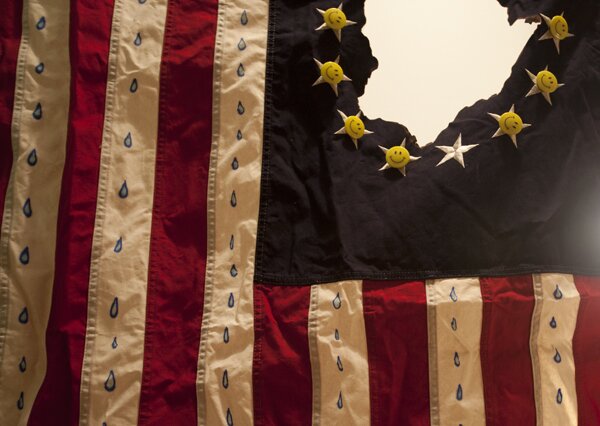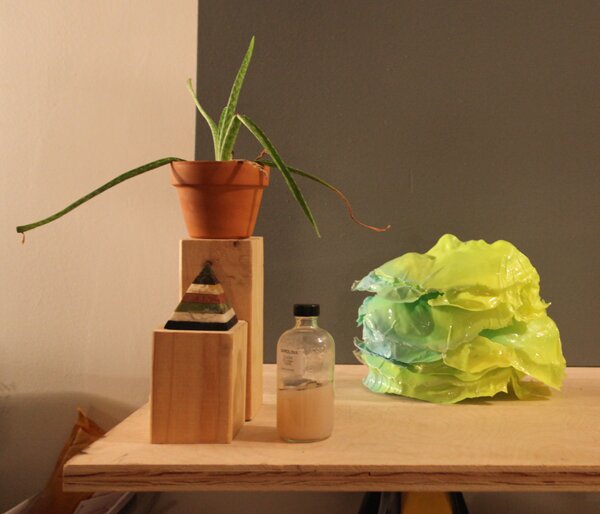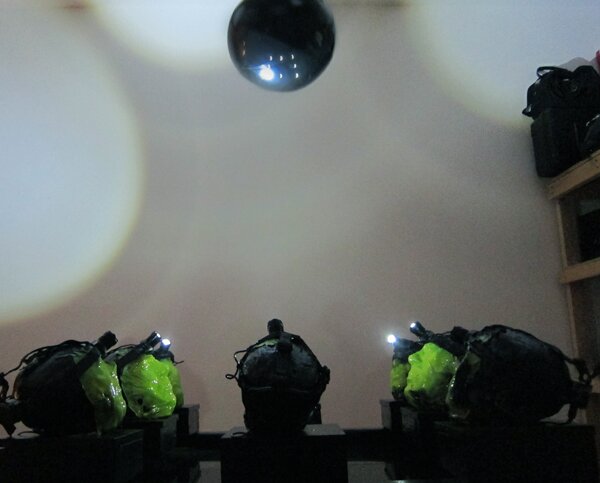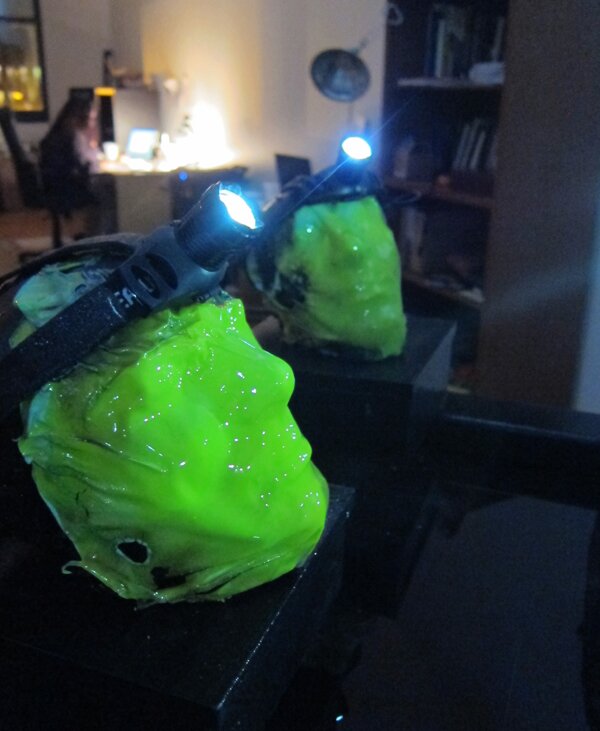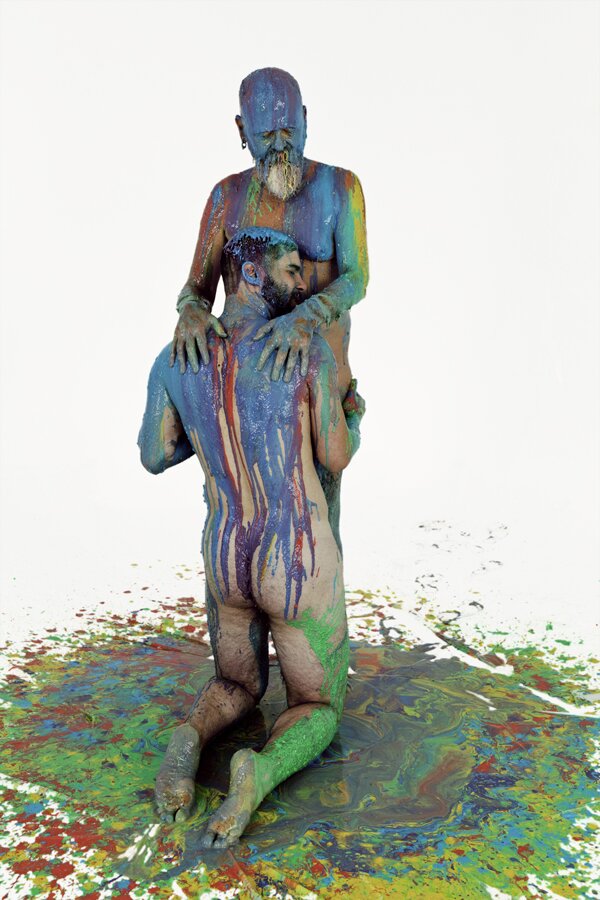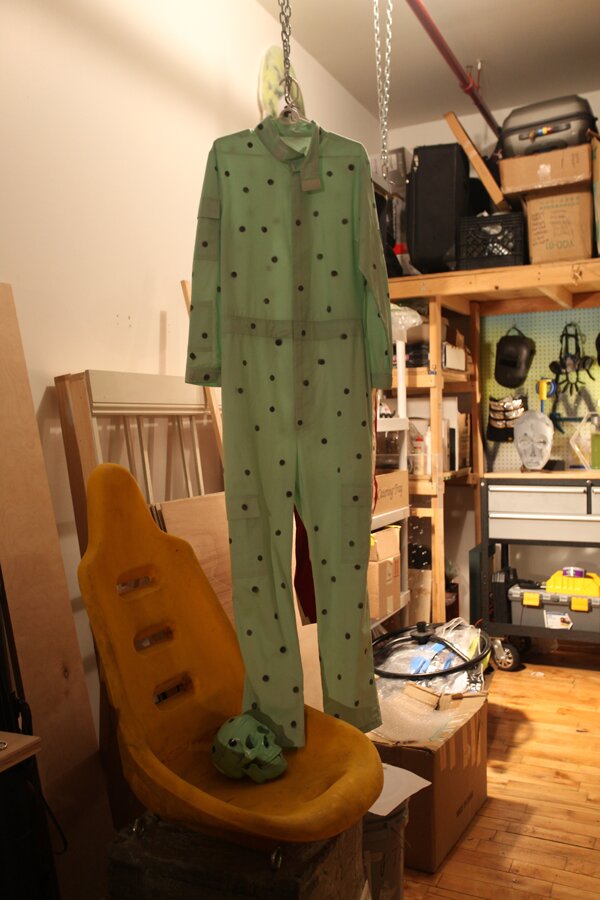We met with at his live/work space located in Bushwick, New York. His work, comprised of pieces from installations and performances, were organized to one side of the loft. During our conversation, we gathered around his computer screen to view his extensive body of work.
Bradford Kessler is currently in his second year of grad school at the School of Visual Arts. He received his BFA in sculpture from the University of Kansas. His work has been exhibited at Tokyo Big Site, Taipei Film Archive, Central Academy of Fine Arts, Beijing, and Electronic Arts Intermix. He has also collaborated with AA Bronson at Art Basel Miami with Esther Schipper, Berlin and Anthology Film Archives, New York.
Bradford is currently in a show titled ‘MATERIAL CONCERNS: Three-Dimensional Objects by Seven Artists’ at . Referencing Eric Drexler’s idea of “grey goo” microscopic robots consuming the Earth, Bradford’s ‘GAR[ ]DEN’ utilizes “garden ornamentation, primitive fetish objects, and landscape painting” to create a garden, or in his words “a an interface between the privacy of the house and the civic property of the street. It is a space onto which others can look, examine and judge. It is a liminal space, a paradise and a prison.” The grey primed canvas is reminiscent of an old Master painting technique where old pigments were mixed together and re-used to create a “perfect ground.”
 Photos courtesy of the artist.
Photos courtesy of the artist.
F: How long have you been in New York and what were you doing before??
BK: For 2 1/2 years. I was in Asia for 6 years before here. I studied Japanese for 2 years and went to China and studied Chinese. In Beijing, I worked for Ai Wei Wei. I made art all the while and showed with a gallery there at the time.
F: And now you’re currently at SVA for graduate school. Do you work here [in this studio space] or do you work there [at the grad studios]? How does that work?
BK: I work here most of the time. I’m there one day a week. I work in the biolab there … it’s the nature and technology lab actually as an Assistant and Researcher. Before grad school, I was teaching at Parsons. I wanted to do a MFA but didn’t feel like I could really commit to a full time program with all that was going on and [at SVA], the low residency set-up really made sense and the list of faculty was really exciting.
F: Can you talk a little bit about your work and what you’re doing now and how it’s changed since going to school and before school?
BK: Since 2005, my was never a portfolio site. It actually functioned like a blog. There’s a lot of Photoshop and Illustrator images that were put together and you can scroll through it. I set it up as if they were these wall works and this guy was looking at them. It was kind of just for fun but then I use a page to show my actual work. So I use my homepage as a blog and a blog as my homepage.
from on .
For the past 2 years … I guess I should start here. This was in Beijing. This was a solo show called that was full of suicidal references and escaping bodily and phenomenological restraints of humaness.. When I came to New York about 2 1/2 years ago, I got on this bio-exorcist kick which was influenced by Beetlejuice. In the film, his job is as a bio-exorcist. The ghost world can hire him to exorcise the living from the house.
One that most embodies that role was Charles Darwin. His ‘Theory of Evolution’ sort of exorcised humans from the spirit realm by placing them on the same level as the animal kingdom in the hierarchy of ‘spirit’ so I made this video. For the animation, I hired this voice actor in LA who did a perfect impersonation of Michael Keaton’s Beetlejuice to read this transcript of George Carlin’s stand-up, and then animated Darwin’s face. So from there, I was like a colorist in a way. I got really obsessed with green. Especially in cinema history, it has always defined the exotic “other,” the evil “other”, aliens, and Frankenstein. It goes on an on, think about the ooze in Ninja Turtles, Slimer, Reanimator…
F: …or the Matrix.
BK: Exactly. If you look over there. I made some of my own ooze. It’s set in … it contains various components of my own DNA and a lot of different things. It’s kind of one of these things that I do that is similar to the things that I would do as a kid like make my own ooze. It’s a fulfillment of my curiousity and playfulness. So the next project I did sort of in this bio-exorcist legacy if you will, was this … it’s called ‘Accident Study’.
There’s an air blower inside of there that shoots air out and the ball hovers above the cube. The headlamps shine on it and casts shadows all around it. I took the title from Aristotle’s claim that there is no study for the accident. So I was thinking of my own art practice as being the exploration of the unknown, researching all the elements of this world that we live in, that can’t really be defined through systems of logic like science and math. So, there’s a lot of references to metaphysics and the paranormal in my work. In this particular work, those are plastic casts of my face, that I was melting over these skulls. I was painting this green effect and thinking of these as the children of the Wicked Witch of the West and so, I was referencing a continuation of manifest destiny. You know, asking the question, “What’s the motivation behind art and technological pursuits?” I was thinking of the Wicked Witch of the West as this intelligent demon lurking in the west. The “civilized” world moved all the way to the west and now with Nasa and the cybernetic age, it’s looking up into the sky. The use of the floating ball was inspired by Primum Mobile which was the black planet that early Greek philosophers thought all the other planets rotated around. It was like the mother planet.
F: It definitely has this X-files/science fiction feeling to it.
BK: Yeah, there definitely is a sci-fi aesthetic to it. The floating ball, you know, you’ll see it at kid’s exploration centers. There are these cliches or tropes of science and art that you’ll find throughout my work. It’s there intentionally. I compare it to David Lynch’s films. His actors will always be delivering this really cheesy dialogue but there will be this suspense music playing behind it and that juxtaposition is so unnerving. So it’s that kind of visceral flavor that I really try to get at. The cliche is there. David Lynch is a big influence. I grew up in a small town in Kansas where there’s always that evil lurking behind the white picket fence.
This was at Art Basel Miami with this past year.
F: Is that a performance piece?
BK: Actually, it was from a short film work but we [ and I] took a still from it and had it produced into a large lightbox.
F: Was it life size?
BK: It was almost life size. It was 4ft by 2ft. We shot it on Super 8. It was for a show at which was based off of the old porn cinemas of New York. It was kind of a divine bukkakae film and so again the slime. Did you grow up watching ‘You Can’t Do That on Television’?
F: Yeah, that Nickelodeon show? It definitely has that influence in it.
BK: Well in that show, the students would get slimed only after they said the key phrase, “I don’t know.” So it was punishment for ignorance and it came from this unknown source above. This all developed from conversations between AA and I. One of Rembrandt’s last paintings is ‘‘ which depicts a parable from the Bible of a son down on his knees begging for forgiveness and his father is embracing him. So we were making a blasphemous take on this with the idea of the divine bukkakae.
There’s quite a bit of my work that’s really rooted in blasphemy which mostly stems from my upbringing in a Baptist church in small town Kansas. Almost all my ideas are drawn from philosophy and psychology. Freud and Lacan have played a role in my work but also Nietzsche and Heidegger. Those guys were tearing a part technology, spirituality, and the pursuit of knowledge itself. You can notice these epic Nietzschean and Freudian themes in my work.
To see more of Bradford’s work, visit his . You can also visit his “website” at and his “blog” at




